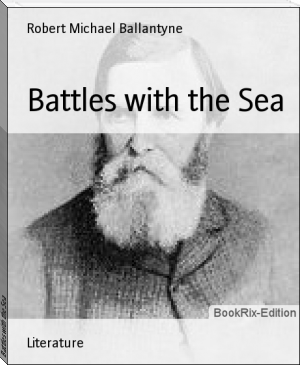Battles with the Sea by Robert Michael Ballantyne (top 100 books of all time checklist txt) 📖

- Author: Robert Michael Ballantyne
Book online «Battles with the Sea by Robert Michael Ballantyne (top 100 books of all time checklist txt) 📖». Author Robert Michael Ballantyne
But there is a great and sudden increase of the spots when we come to England. They commence at the border, on the west, where vessels from and to the busy Clyde enter or quit the Irish Sea. Darkening the fringes of the land on both sides, and clustering round the Isle of Man, they multiply until the ports have no room to hold them, and, as at Liverpool, they are crowded out into the sea. From the deadly shores of Anglesea, where the Royal Charter went down in the great and memorable storm of November, 1859, the signs of wreck and disaster thicken as we go south until we reach the Bristol Channel, which appears to be choked with them, and the dangerous cliffs of Cornwall, which receive the ill-fated vessels of the fleets that are perpetually leaving or entering the two great channels. But it is on the east coast of England that the greatest damage is done. From Berwick to the Thames the black spots cluster like bees. On the coasts of Norfolk and Suffolk, off Great Yarmouth, where lie the dangerous Haisborough Sands, the spots are no longer in scattered groups, but range themselves in dense battalions; and further south, off the coast of Kent, round which the world's commerce flows unceasingly into the giant metropolis, where the famous Goodwin Sands play their deadly part in the great war, the dismal spots are seen to cluster densely, like gnats in a summer sky.
Now, just where the black spots are thickest on this wreck chart, lifeboats and rocket apparatus have been stationed in greatest numbers. As in ordinary warfare, so in battles with the sea, our "Storm Warriors" [See an admirable book, with this title, written by the Reverend John Gilmore, of Ramsgate. (Macmillan and Company)] are thrown forward in force where the enemy's assaults are most frequent and dangerous. Hence we find the eastern shores of England crowded at every point with life-saving apparatus, while most of the other dangerous parts of the coast are pretty well guarded.
Where and how do our coast heroes fight? I answer--sometimes on the cliffs, sometimes on the sands, sometimes on the sea, and sometimes even on the pierheads. Their operations are varied by circumstances. Let us draw nearer and look at them while in action, and observe how the enemy assails them. I shall confine myself at present to a skirmish.
When the storm-fiend is abroad; when dark clouds lower; when blinding rain or sleet drives before the angry gale, and muttering thunder comes rolling over the sea, men with hard hands and weather-beaten faces, clad in oilskin coats and sou'-westers, saunter down to our quays and headlands all round the kingdom. These are the lifeboat crews and rocket brigades. They are on the lookout. The enemy is moving, and the sentinels are being posted for the night--or rather, they are posting themselves, for nearly all the fighting men in this war are volunteers!
They require no drilling to prepare them for the field; no bugle or drum to sound the charge. Their drum is the rattling thunder; their trumpet the roaring storm. They began to train for this warfare when they were not so tall as their fathers' boots, and there are no awkward squads among them now. Their organisation is rough-and-ready, like themselves, and simple too. The heavens call them to action; the coxswain grasps the helm, the oars are manned, the word is given, and the rest is straightforward fighting--over everything, through everything, in the teeth of everything, until the victory is gained, and rescued men, women, and children are landed in safety on the shore.
Of course they do not always succeed, but they seldom or never fail to do the very uttermost that it is in the power of strong and daring men to accomplish. Frequently they can tell of defeat and victory on the same battlefield.
So it was on one fearful winter night at the mouth of the Tyne in the year 1867. The gale that night was furious. It suddenly chopped round to the South South East, and, as if the change had recruited its energies, it blew a perfect hurricane between midnight and two in the morning, accompanied by blinding showers of sleet and hail, which seemed to cut like a knife. The sea was rising mountains high.
About midnight, when the storm was gathering force and the sentinels were scarcely able to keep a lookout, a preventive officer saw a vessel driving ashore to the south of the South Pier. Instantly he burnt a blue light, at which signal three guns were fired from the Spanish Battery to call out the Life Brigade. The men were on the alert. About twenty members of the brigade assembled almost immediately on the pier, where they found that the preventive officer and pier-policeman had already got out the life-saving apparatus; but the gale was so fierce that they had been forced to crawl on their hands and knees to do so. A few minutes more and the number of brigade men increased to between fifty and sixty. Soon they saw, through the hurtling storm, that several vessels were driving on shore. Before long, four ships, with their sails blown to ribbons, were grinding themselves to powder, and crashing against each other and the pier-sides in a most fearful manner. They were the Mary Mac, the Cora, and the Maghee, belonging to Whitstable, and the Lucern of Blyth.
Several lifeboats were stationed at that point. They were all launched, manned, and promptly pulled into the Narrows, but the force of the hurricane and seas were such that they could not make headway against them. The powers of man are limited. When there is a will there is not always a way! For two hours did these brave men strain at the tough oars in vain; then they unwillingly put about and returned, utterly exhausted, leaving it to the men with the life-lines on shore to do the fighting. Thus, frequently, when one arm of the service is prevented from acting; the other arm comes into play.
The work of the men engaged on the pier was perilous and difficult, for the lines had to be fired against a head wind. The piers were covered with ice, and the gale was so strong that the men could hardly stand, while the crews of the wrecks were so benumbed that they could make little effort to help themselves.
The men of the Mary Mac, however, made a vigorous effort to get their longboat out. A boy jumped in to steady it. Before the men could follow, the boat was stove in, the rope that held it broke, and it drove away with the poor lad in it. He was quickly washed out, but held on to the gunwale until it drifted into broken water, when he was swallowed by the raging sea and the boat was dashed to pieces.
Meanwhile the crew of the Cora managed to swing themselves ashore, their vessel being close to the pier. The crew of the Lucern, acting on the advice of the brigade men, succeeded in scrambling on board the Cora and were hauled ashore on the life-lines. They had not been ten minutes out of their vessel when she turned over with her decks towards the terrible sea, which literally tore her asunder, and pitched her up, stem on end, as if she had been a toy. The crew of the Maghee were in like manner hauled on to the pier, with the exception of one lad from Canterbury. It was the poor boy's first voyage. Little did he think probably, while dreaming of the adventures of a sailor's career, what a terrible fate awaited him. He was apparently paralysed with fear, and could not spring after his comrades to the pier, but took to the rigging. He had scarcely done so when the vessel heeled over, and he was swung two or three times backwards and forwards with the motion of the masts.
It is impossible to imagine the feelings of the brave men on the pier, who would so gladly have risked their lives to save him--he was so near, and yet so hopelessly beyond the reach of human aid!
In a very brief space of time the waves did their work--ship and boy were swallowed up together.
While these events were enacting on the pier the Mary Mac had drifted over the sand about half a mile from where she had struck. One of her crew threw a leadline towards a seaman on the shore. The hero plunged into the surf and caught it. The rest of the work was easy. By means of the line the men of the Life Brigade sent off their hawser, and breeches-buoy or cradle (which apparatus I shall hereafter explain), and drew the crew in safety to the land.
That same morning a Whitby brig struck on the sands. The lifeboat Pomfret, belonging to the Royal National Lifeboat Institution, put out and rescued her crew. In the morning the shores were strewn with wreckage, and amongst it was found the body of the boy belonging to the Mary Mac.
All these disasters were caused by the masters of the vessels mistaking the south for the north pier, in consequence of having lost sight of Tynemouth light in the blinding showers.
Of course many lifeboats were out doing good service on the night to which I have referred, but I pass all that by at present. The next chapter will carry you, good reader, into the midst of a pitched battle.
CHAPTER TWO.
DESCRIBES A TREMENDOUS BATTLE AND A GLORIOUS VICTORY.
Before following our brilliant lifeboat--this gaudy, butterfly-like thing of red, white, and blue--to the field of battle, let me observe that the boats of the Royal National Lifeboat Institution have several characteristic qualities, to which reference shall be made hereafter, and that they are of various sizes. [A full and graphic account of the Royal National Lifeboat Institution--its boats, its work, and its achievements--may be found in an interesting volume by its late secretary, Richard Lewis, Esquire, entitled _History of the Lifeboat and its Work_--published by Macmillan and Company.]
One of the largest size is that of Ramsgate. This may be styled a privileged boat, for it has a steam-tug to wait upon it named the Aid. Day and night the Aid has her fires "banked up" to keep her boilers simmering, so that when the emergency arises, a vigorous thrust of her giant poker brings them quickly to the boiling point, and she is ready to take her lifeboat in tow and tug her out to the famed and fatal Goodwin Sands, which lie about four miles off the coast--opposite to Ramsgate.
I draw attention to this boat, first because she is exceptionally situated with regard to frequency of call, the means of going promptly into action, and success in her work. Her sister-lifeboats of Broadstairs and Margate may, indeed, be as often called to act, but they lack the attendant steamer, and sometimes, despite the skill and courage of their crews, find it impossible to get out in the teeth of a
 Have you ever thought about what fiction is? Probably, such a question may seem surprising: and so everything is clear. Every person throughout his life has to repeatedly create the works he needs for specific purposes - statements, autobiographies, dictations - using not gypsum or clay, not musical notes, not paints, but just a word. At the same time, almost every person will be very surprised if he is told that he thereby created a work of fiction, which is very different from visual art, music and sculpture making. However, everyone understands that a student's essay or dictation is fundamentally different from novels, short stories, news that are created by professional writers. In the works of professionals there is the most important difference - excogitation. But, oddly enough, in a school literature course, you don’t realize the full power of fiction. So using our website in your free time discover fiction for yourself.
Have you ever thought about what fiction is? Probably, such a question may seem surprising: and so everything is clear. Every person throughout his life has to repeatedly create the works he needs for specific purposes - statements, autobiographies, dictations - using not gypsum or clay, not musical notes, not paints, but just a word. At the same time, almost every person will be very surprised if he is told that he thereby created a work of fiction, which is very different from visual art, music and sculpture making. However, everyone understands that a student's essay or dictation is fundamentally different from novels, short stories, news that are created by professional writers. In the works of professionals there is the most important difference - excogitation. But, oddly enough, in a school literature course, you don’t realize the full power of fiction. So using our website in your free time discover fiction for yourself. 




Comments (0)